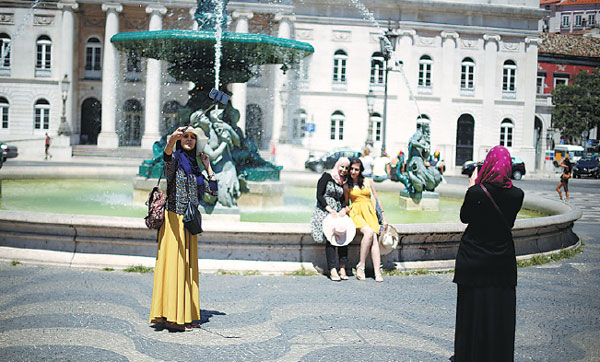Portugal working to protect world heritage sites
Portugal has made considerable efforts in the past decade to protect its 15 UNESCO World Heritage sites, including Sintra, which is located some 30 kilometers northwest of the capital Lisbon.
"Portugal was faced with a number of problems regarding management and deterioration of structures in the 1990s, but the situation has improved," says Mechtild Rossler, director of the Division for Heritage and the UNESCO World Heritage Center.
Following local complaints and awareness by the World Heritage Center that all was not going as planned after Sintra's inscription in 1995, a reactive monitoring mission was carried out in 2000.
|
Tourists take pictures at Rossio square in downtown Lisbon. Reuters |
The World Heritage Committee requested a report on the restoration program, including monuments, gardens, parks, and forests and improvement of management to be undertaken in the following six years.
The practical steps requested were the creation of an independent Cultural Landscape Advisory Committee, the creation of an advisory body or association of residents, establishment of a public information and research archives center, and an adjustment of the high protection area of the natural park to coincide with the core area of the World Heritage Site.
Another monitoring mission was carried out in 2006 by the World Heritage Center to follow up on Sintra's situation and progress, and it was noted that "progress was slow and that the management system has not been adapted to the requirements under the World Heritage Center".
The Parques de Sintra-Monte da Lua was founded in 2000, and was in charge of managing the cultural landscape's most important monuments and gardens.
Nowadays, Sintra has a Scientific Council of specialists in natural and cultural heritage that advises on protection, conservation and restoration issues. It has formed partnerships with universities and investigation centers, enabling the process of conservation and restoration to be supported by multidisciplinary studies.
Sintra depends mainly on tourism revenue and visitors, since it receives no funding from the state. Therefore, its management model focuses mainly on generating revenue through inflows of visitors, while trying to find ways to make tourism sustainable.
It managed to attract around 2 million visitors last year, meaning the number of visitors rose by over 15 percent in just a year. Its management structure has received international acclaim, with Parques de Sintra picking up the World Travel Award for the "World's Leading Conservation Company" category for the third consecutive time last year at an official ceremony in Morocco.
According to the report "Portugal and World Heritage, 30 Years of Best Practices," the programs carried out following a meeting between site managers of World Heritage sites in Portugal and the Portuguese National Commission for UNESCO in 2014, sustainable tourism has been achieved through "rehabilitation and enhancement of the monuments and parks, the opening of new areas to the public, the improvement of the visitor experience and the diversification of services and activities available such as guided visits, thematic walks, courses and workshops, cultural animation, cafeterias and shops."
In addition, "sustainable mobility solutions have also been implemented, such as a network of footpaths, electrical bicycles and an equestrian tourism program."
The high flux of tourism in Sintra is balanced by diversifying the promotion of points of interest and creating alternative experiences, according to its annual accounts report for 2015.
While construction work can be unpleasant for visitors, Parques de Sintra-Montes da Lua has endorsed the concept of "Open for Works", which means visitors can witness rehabilitation work close up. Technicians are also open to answer questions regarding the works.
The rehabilitation of the medieval kitchen of the National Palace of Sintra, for example, which is notable for its two chimneys of around 33 meters, was completed in May this year.
The work lasted three months. The objective was to minimize the anomalies of the 19th century tiles that cover the walls, cookers and ovens among other elements.
Last year, the council of Sintra and Parques de Sintra-Monte da Lua signed a protocol to create an office to monitor the area classified as world heritage by UNESCO, with the mission to promote and bring together interested parties through a debate of ideas regarding the management and rehabilitation of the heritage.
Another objective was to promote scientific and technical studies and to monitor interventions by public and private entities in the protected areas.
Xinhua



















